History. The Onassis Library began to take shape, albeit unofficially, following the death of shipping magnate and businessman Aristotle Onassis in 1975. It formed part of the Alexander S. Onassis Public Benefit Foundation, the creation of which had been decided by Aristotle a year earlier. The main objective of the Foundation, which was named after Aristotle’s son Alexander (1948–1973), following his untimely death in a plane crash, was the advancement and expansion of Hellenic culture.
It formed part of the Alexander S. Onassis Public Benefit Foundation, the creation of which had been decided by Aristotle a year earlier. The main objective of the Foundation, which was named after Aristotle’s son Alexander (1948–1973), following his untimely death in a plane crash, was the advancement and expansion of Hellenic culture.
The core components of Onassis Library came from Aristotle’s personal collection and consisted of 1,150 titles dating from the 16th to the 20th century. These books were originally located in the Greek magnate’s business offices in Monte Carlo and on the yacht “Christina”. After his death, they were transported to Athens along with his library, furniture and various personal effects. Onassis' collection mainly includes works of literature, treatises on the arts, and collections of poetry, as well as volumes on history, travel and archaeology. Furthermore, the collection includes books on maritime entrepreneurship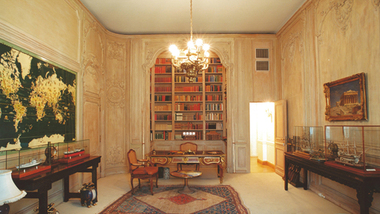 , as well as valuable reference tools like atlases and encyclopaedias. Finally, among these publications, one can find gifts from fellow businessmen and friends, dedicated to Aristotle and his family. Nowadays, his books, furniture, the desk from his office in Monte Carlo, as well as other personal belongings and works of art, are housed in a special hall dedicated to the great benefactor on the second floor of the neoclassical building at 56, Amalias Avenue.
, as well as valuable reference tools like atlases and encyclopaedias. Finally, among these publications, one can find gifts from fellow businessmen and friends, dedicated to Aristotle and his family. Nowadays, his books, furniture, the desk from his office in Monte Carlo, as well as other personal belongings and works of art, are housed in a special hall dedicated to the great benefactor on the second floor of the neoclassical building at 56, Amalias Avenue.
The history of the Onassis Library took a different turn in 2010, when the Board of Directors of the Alexander S. Onassis Public Benefit Foundation, chaired by Antonis Papadimitriou, decided to acquire the collection of architect and book historian Konstantinos Sp. Staikos. Other collections were added along the way and, as a result, the Library today consists of the following sections in addition to A. Onassis Collection: the K. Sp. Staikos Collection — Hellenic Library, the Travel Library, the Collection of 20th Century Literature, the C. P. Cavafy Archive, the Historical Archive and the A. Onassis Business Archive.
The building. The neoclassical building housing the Onassis Library was designed by the architect Anastasios Metaxas (1862–1937), the scholar responsible for the renovation of the Panathenaic Stadium. On that project, Metaxas remained loyal to the understated principles of neoclassicism, encouraging a harmonious co-existence with the surrounding archaeological monuments, 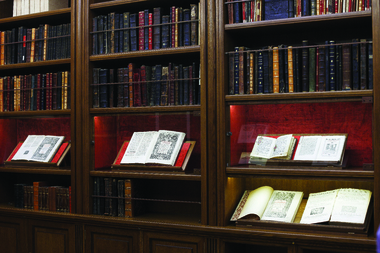 in contrast to the movement of eclecticism, the dominant architectural style of the early 20th century. The building, constructed in 1905 at the junction of Amalias Avenue and Dionysiou Areopagitou Street, originally was the home of Egyptian-born Greek lawyer Georgios Orphanidis, who was engaged in the cotton trade, and his wife, Olga Saroglou, sister of Petros Saroglou, who bequeathed the Sarogleion Mansion to the state.
in contrast to the movement of eclecticism, the dominant architectural style of the early 20th century. The building, constructed in 1905 at the junction of Amalias Avenue and Dionysiou Areopagitou Street, originally was the home of Egyptian-born Greek lawyer Georgios Orphanidis, who was engaged in the cotton trade, and his wife, Olga Saroglou, sister of Petros Saroglou, who bequeathed the Sarogleion Mansion to the state.
During the 1930s, the property became home to the family of the Orphanidis’ daughter Elisabeth Kalliga. Later, around 1937–1938, the Italian School of Archaeology was established and remained there until 1950. More recently, it housed the Greek branch of the World Crafts Council (WCC) — headed at the time by Michael Goutos — who used the building as an exhibition space. The last owners, from whom a company controlled by the Onassis Foundation acquired the building, were the members of the Nastos family.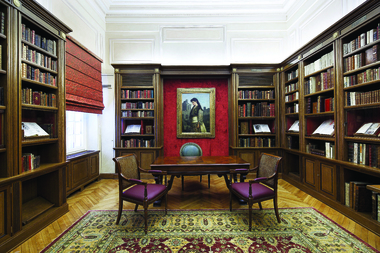 In 1991, the Onassis Foundation’s restorative work on the building began, with great respect towards its historical significance and style, but also guided by the need to place it within a new cultural and administrative framework. Today, the Onassis Library can be found on the first floor, while one of the halls of the second floor features the office of Aristotle Onassis, transferred directly from Monte Carlo with his furniture and personal effects in place. The auxiliary spaces of the third floor, which lead to the upper veranda with an unobstructed view of the Acropolis, have been remodelled into a board room and a dining hall, furnished with additional items from Onassis’ legendary yacht.
In 1991, the Onassis Foundation’s restorative work on the building began, with great respect towards its historical significance and style, but also guided by the need to place it within a new cultural and administrative framework. Today, the Onassis Library can be found on the first floor, while one of the halls of the second floor features the office of Aristotle Onassis, transferred directly from Monte Carlo with his furniture and personal effects in place. The auxiliary spaces of the third floor, which lead to the upper veranda with an unobstructed view of the Acropolis, have been remodelled into a board room and a dining hall, furnished with additional items from Onassis’ legendary yacht.
In addition to taking part in its educational programmes, visitors of the Onassis Library are given the opportunity to explore the Onassis Foundation collection, consisting of paintings, sculptures and unique artefacts. The renowned paintings in this set include “Sailing Ships” by Konstantinos Volanakis, “Shepherd Boy” by Georgios Jakobides, “Young Sailor” by Nikiforos Lytras, “Landscape” by Konstantinos Parthenis, and “Coronation of the Virgin” by Domḗnikos Theotokópoulos (El Greco).
Sculpture highlights include “The Reaper” by Dimitrios Filippotis, the marble hearths and the “Hecatoncheir” bust by Yannoulis Chalepas, the statues “Eos” and “Vesper” by Georgios Vroutos, as well as “Orpheus’ Sorrow” by pre-eminent French sculptor Charles Raoul Verlet.
Finally, the most recognisable object of unique value housed in the headquarters of the Onassis Library is the Steinway & Sons Model S. Baby Grand piano, purchased by Aristotle Onassis in 1952 for Maria Callas and specially designed to withstand the humidity of the yacht “Christina”.
K. Sp. Staikos Collection – Hellenic Library. K. Sp. Staikos began to collect books on a regular basis in the mid-1970s, when he came across a book, printed in the first Greek-owned printing house,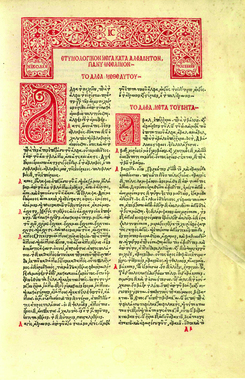 that of Nikolaos Vlastos and Zacharias Kalliergis in Venice (1499–1500). Captivated by the volume’s elegance and influenced by the professional relationships he maintained with representatives of the literary and publishing world at that time, Staikos began his study of the first Greek typographers while at the same time collecting books related to the publishing and printing activity of Greeks from the invention of typography to the late 19th century.
that of Nikolaos Vlastos and Zacharias Kalliergis in Venice (1499–1500). Captivated by the volume’s elegance and influenced by the professional relationships he maintained with representatives of the literary and publishing world at that time, Staikos began his study of the first Greek typographers while at the same time collecting books related to the publishing and printing activity of Greeks from the invention of typography to the late 19th century.
As Staikos himself recounts, his involvement with the Hellenic Bibliophile Society (1975) during that time was a determining factor in his development as a collector. The Society was comprised of academics and bibliophiles (Constantinos Tsatsos,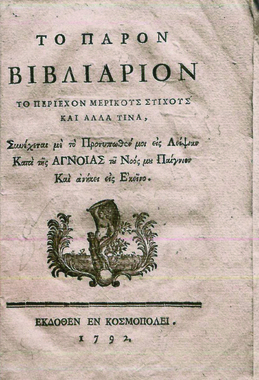 Loukia Droulia, Aikaterini Koumarianou, Nikos Hatzikyriakos Gikas, Maria Koutarelou, Yiannis Fikioris et al.) who devoted themselves to activities (publications, exhibitions, presentations, etc.) related to the promotion of Greek typography. Furthermore, his acquaintance with the antiquarian bookseller and historian Georgios Ladas introduced him to printing activity during the period of Ottoman rule, while his work on the library of politician Leon Melas (1812–1879) brought him into direct contact with texts of the ancient and Byzantine eras. In fact, an important part of this library, the one pertaining to the Renaissance era, was subsequently annexed to Staikos’ library.
Loukia Droulia, Aikaterini Koumarianou, Nikos Hatzikyriakos Gikas, Maria Koutarelou, Yiannis Fikioris et al.) who devoted themselves to activities (publications, exhibitions, presentations, etc.) related to the promotion of Greek typography. Furthermore, his acquaintance with the antiquarian bookseller and historian Georgios Ladas introduced him to printing activity during the period of Ottoman rule, while his work on the library of politician Leon Melas (1812–1879) brought him into direct contact with texts of the ancient and Byzantine eras. In fact, an important part of this library, the one pertaining to the Renaissance era, was subsequently annexed to Staikos’ library.
The deciding factor, however, that influenced the formation of Staikos’ personal library, as well as the enrichment of his knowledge regarding the subjects of the book and Greek typography from the late Byzantine period to the late 20th century, was his two-year “term” working on the library of physician, bibliophile and bibliographer Athanasios D. Hadjidemos (1910–1967).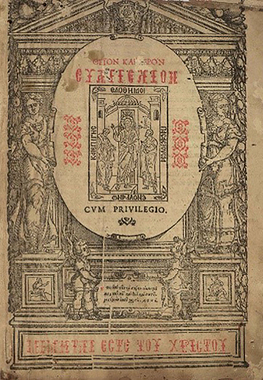 In 1979, Katy Hadjidemos, heiress to the library, decided to sell approximately the 14,000 volumes and a significant number of pamphlets that made up Hatjidemos’ library. Staikos was invited, along with Chryssa Maltezou, researcher at the Centre for Byzantine Research of the National Hellenic Research Foundation and today a member of the Academy of Athens, to assess the Hadjidemos library and to identify academic establishments and other cultural institutions as potential buyers.
In 1979, Katy Hadjidemos, heiress to the library, decided to sell approximately the 14,000 volumes and a significant number of pamphlets that made up Hatjidemos’ library. Staikos was invited, along with Chryssa Maltezou, researcher at the Centre for Byzantine Research of the National Hellenic Research Foundation and today a member of the Academy of Athens, to assess the Hadjidemos library and to identify academic establishments and other cultural institutions as potential buyers.
The artefacts ended up at the Gennadius Library and the Library of the Hellenic Parliament among others, while a limited number of books was acquired by the Library of the University of Crete in Rethymnon. Staikos himself procured approximately 500 of unique or rare publications, including rare liturgical editions, which to this day constitute the core of the Hellenic Library (formerly known as K. Sp. Staikos Collection) of Onassis Foundation.
The Hellenic Library’s expansion continued at a rapid pace during the 1980s and 1990s, mainly through purchases as well as donations. Some of Dionysios Flambouras’ books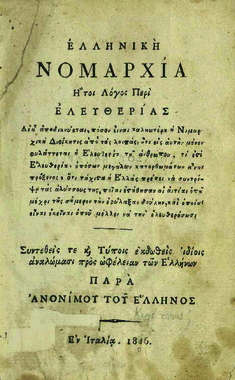 (mainly Greek publications from printing houses of France and Germany), as well as his valuable archive, passed into the hands of Staikos at the initiative of Flambouras’ widow, Maria Flambouras. Staikos also acquired books of great value from the collection of K. T. Dimaras: among these were early examples of the art of printing in the Hellenic world, writings pertaining to the march of the Greeks towards the Revolution of 1821, such as the Hellenic Nomarchy [Rule of Law] of 1806, or liturgical books from the 16th century, such as the Eirmologion printed in Venice by the house of Andreas Kounadis in 1568.
(mainly Greek publications from printing houses of France and Germany), as well as his valuable archive, passed into the hands of Staikos at the initiative of Flambouras’ widow, Maria Flambouras. Staikos also acquired books of great value from the collection of K. T. Dimaras: among these were early examples of the art of printing in the Hellenic world, writings pertaining to the march of the Greeks towards the Revolution of 1821, such as the Hellenic Nomarchy [Rule of Law] of 1806, or liturgical books from the 16th century, such as the Eirmologion printed in Venice by the house of Andreas Kounadis in 1568.
Other notable acquisitions of the K. Sp. Staikos Collection included hard-to-find editions by short-lived printing shops acquired from the Martakos library; 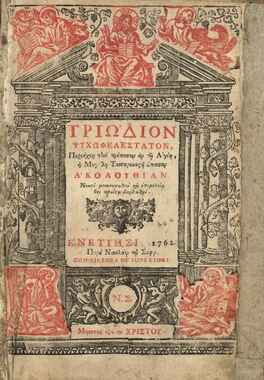 rare publications from Moscow and St. Petersburg printers, originally part of the collections of Stefanos N. Dragoumis and Dionysios Loverdos; monastic literature and other valuable books on Byzantine history and art, the Ottoman Empire and the Greek War of Independence, from the collections of the rulers of Wallachia and Moldavia (Alexandros Mavrokordatos and others), which had come to the great library of merchant Georgios I. Arvanitidis (1876–1953) from Constantinople. A large part of Arvanitidis library now forms part of the closed collections of the Library of the University of Crete.
rare publications from Moscow and St. Petersburg printers, originally part of the collections of Stefanos N. Dragoumis and Dionysios Loverdos; monastic literature and other valuable books on Byzantine history and art, the Ottoman Empire and the Greek War of Independence, from the collections of the rulers of Wallachia and Moldavia (Alexandros Mavrokordatos and others), which had come to the great library of merchant Georgios I. Arvanitidis (1876–1953) from Constantinople. A large part of Arvanitidis library now forms part of the closed collections of the Library of the University of Crete.
When not directly sourced from the estates of their original owners, the new acquisitions were purchased through foreign auction houses (Sotheby’s, Christie’s), which sold books from famous libraries, such as those of Chatsworth, the Duke of Devonshire, the Broxbourne Library, et al. At the same time many purchases were made directly by the collector himself from the historic bookstores of Magg’s and Quaritch in London, Diana Parikian in Oxford, Luigi Gonelli in Florence, et al.
After 1986, Staikos turned to the acquisition of works by Greek scholars and printers who lived and worked during the Italian Renaissance (late 14th-mid-16th century)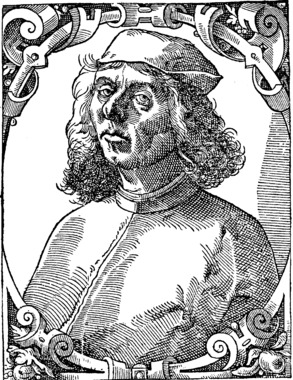 , such as Manuel Chrysoloras, George of Trebizond, Cardinal Bessarion, Theodorus Gaza, Zacharias Calliergi, Nikolaos Vlastos, Michael Tarchaniota Marullus and many more. These books were even presented by Staikos in exhibitions organised in Florence (1986), at the Benaki Museum (1987), at the University of Geneva (1988), in Strasbourg (1989) and elsewhere, highlighting the valuable contribution of Greek scholars to the dissemination of Greek letters during the Renaissance.
, such as Manuel Chrysoloras, George of Trebizond, Cardinal Bessarion, Theodorus Gaza, Zacharias Calliergi, Nikolaos Vlastos, Michael Tarchaniota Marullus and many more. These books were even presented by Staikos in exhibitions organised in Florence (1986), at the Benaki Museum (1987), at the University of Geneva (1988), in Strasbourg (1989) and elsewhere, highlighting the valuable contribution of Greek scholars to the dissemination of Greek letters during the Renaissance.
Presentations of the Collection continued during the 1990s, with a significant part of its printed material being exhibited in historical libraries and institutions abroad, such as the Institute of Byzantine and Post-Byzantine Studies in Venice in 1993, the Imperial Library of Vienna in 1995, but also in Strasbourg and The Hague in the Netherlands. In 1999, the Foundation of the Hellenic Parliament commissioned Staikos, in collaboration with the historian Triantafyllos Sklavenitis, to organise the exhibition “500 Years of Printed Text Tradition in Modern Greece”. A publication of the same name was released within the context of this exhibition (see “Bibliography”).
The Staikos Library had by now developed its own distinct identity by including printed books that related to the development of publishing and typography in the Hellenic world during the period of Ottoman rule,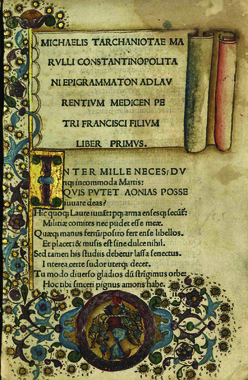 from the beginnings of printing in the 15th century to the early 19th century, thus illuminating all facets of the Genus: language, cultural tradition and the orthodox faith. The library also had the potential to become a treasure trove within which one could search for every printed book from the aforementioned times, once it opened its doors to the public. An indication of its importance was the fact that, among its 8,000 titles total, the Library had come to number around 1,400 titles and 2,000 copies of editions that had been printed in Greek, Latin and other languages between the 15th and 19th centuries, primarily in Venice, but also in the printing houses of other major urban centres of the time (Florence, Rome, Paris, Geneva, London, Istanbul, et al.).
from the beginnings of printing in the 15th century to the early 19th century, thus illuminating all facets of the Genus: language, cultural tradition and the orthodox faith. The library also had the potential to become a treasure trove within which one could search for every printed book from the aforementioned times, once it opened its doors to the public. An indication of its importance was the fact that, among its 8,000 titles total, the Library had come to number around 1,400 titles and 2,000 copies of editions that had been printed in Greek, Latin and other languages between the 15th and 19th centuries, primarily in Venice, but also in the printing houses of other major urban centres of the time (Florence, Rome, Paris, Geneva, London, Istanbul, et al.).
Since the early 2000s, Staikos became strongly preoccupied with the future of his Library. The rescue and enrichment of its material, as well as open access to it for research purposes, were the conditions that had to be met 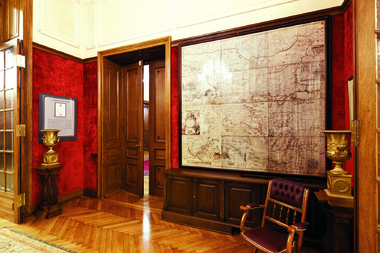 in order to ensure its smooth development. The Alexander S. Onassis Public Benefit Foundation was the body that was going to honour the founder’s terms, eventually acquiring the Library in 2010. As pointed out by the Foundation’s President, Antonis Papadimitriou, the decision to acquire the collection of K.Sp. Staikos, which would heretofore be known as the “Library of the Alexander S. Onassis Public Benefit Foundation”, was made in order to “preserve these books as possession for all time of the Greek nation... to be made accessible to researchers and eventually online, so that as many visitors as possible may reach them in any format”.
in order to ensure its smooth development. The Alexander S. Onassis Public Benefit Foundation was the body that was going to honour the founder’s terms, eventually acquiring the Library in 2010. As pointed out by the Foundation’s President, Antonis Papadimitriou, the decision to acquire the collection of K.Sp. Staikos, which would heretofore be known as the “Library of the Alexander S. Onassis Public Benefit Foundation”, was made in order to “preserve these books as possession for all time of the Greek nation... to be made accessible to researchers and eventually online, so that as many visitors as possible may reach them in any format”.
The Hellenic Library, which is constantly being enriched, currently numbers over 3,000 titles, from the 15th to the 19th century, classed into five main sections:
- Renaissance / Humanism: Works of ancient Greek authors, humanistic works, grammars, encyclopaedias, lexicons, philosophical treatises and essays. The main core of this section is made up of first editions of works of classical and Hellenistic literature, as well as writings compiled by Byzantine scholars for the purpose of teaching the Greek language. Examples include: the Grammar of Theodorus Gaza (Venice 1495), the first edition of the Odes (Olympian, Pythian, Nemean, Isthmian) by Pindar (the first Greek book printed in Rome, in 1515), the Erotemata by Manuel Chrysoloras (Venice 1540), the Grammar of Constantine Lascaris (Venice 1542) and many others. These publications, featuring the original text and/or its Latin translation, would go on to form the basis of university education in the higher learning institutions of Italy, and also throughout Europe and Britain.
- Modern Greek Literature: Literary works, collections of poetry, popular readings, historical writings, works of philosophy, essays, grammars and lexicons, school textbooks.
- Liturgical books: Gospels, Menaia, services of worship, Psalters, Books of Hours (Horologion), Pentecostaria, Euchologia.
- Theological writings: Patristic texts, Βibles, confessions of faith, doctrinal texts, works on the history of the Church and Orthodox Christianity by authors such as John Chrysostom, Basil the Great, Gregory of Nazianzus, Maximus the Confessor, et al.
- Neohellenic Enlightenment: Original works published to raise the spirits of the Greeks by preparing the ground for the proclamation of the Revolution, Greek translations of works of world literature, works representative of the philological and linguistic debates unfolding within the European Enlightenment and the intellectual currents that emerged from the French Revolution.
The last four sections feature books of all kinds, which were published by Greek scholars (whether as authors or editors) and printers, with the goal of contributing to education and enlightenment and promoting the unity of the Greeks.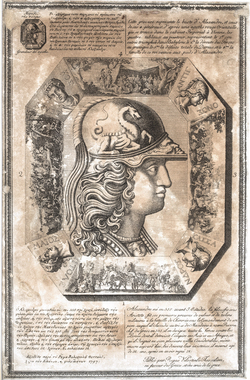 The liturgical books that were used as educational tools also served this purpose. The systematic production of books addressed to Greek readers began around 1497, when Corfu scholar Justin Dekadyos published the Psalter (Venice, Aldus Manutius), encouraging Greeks everywhere to cultivate the three basic elements of Hellenic identity: language, cultural tradition and the orthodox faith. A copy of the book is preserved at the Library of Onassis Foundation.
The liturgical books that were used as educational tools also served this purpose. The systematic production of books addressed to Greek readers began around 1497, when Corfu scholar Justin Dekadyos published the Psalter (Venice, Aldus Manutius), encouraging Greeks everywhere to cultivate the three basic elements of Hellenic identity: language, cultural tradition and the orthodox faith. A copy of the book is preserved at the Library of Onassis Foundation.
Most books addressed to the Greeks were originally printed in Greek printing houses in Venice, where maritime trading ensured their circulation across all ports of the Mediterranean and the Black Sea. From the mid-18th century onward, the European Enlightenment and subsequent Neo-Hellenic Enlightenment mobilised the Greeks of the diaspora, the mainland and others, who set up printing shops in Vienna, Bucharest, Iași, Leipzig, Trieste, Buda, Pest, Moscow, Petersburg, Paris, Constantinople, Moscopole, Smyrna, Mount Athos, Corfu, Zakynthos and Chios.
In Vienna, the publishing and printing activity by both Greek and foreign printers, such as Thomas von Trattner and Georgios Vendotis, turned the Austrian capital into the epicenter of Hellenic publishing activity, as from the mid-18th century 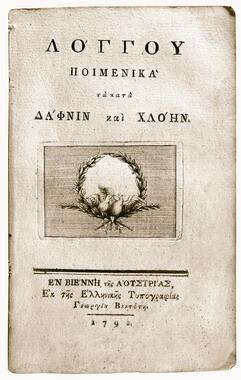 until the third decade of the 19th century, a significant number of publications were issued there with the objective of lifting the spirits of Greeks everywhere and paving the way for the Greek War of Independence. The Anthology of Physics (1790) and the Charta (1796/7) by Rigas Velestinlis, the Theory of Geography by Iosipos Moisiodax (1781), the translated Travels of Cyrus (1783) by A. Ramsey, the History of America (1792) by W. Robertson and the Concise History of Medicine (1794), translated by C. Michael and printed by Joseph Baumeister, are but a few of the publications in this category that are kept at the Onassis Library.
until the third decade of the 19th century, a significant number of publications were issued there with the objective of lifting the spirits of Greeks everywhere and paving the way for the Greek War of Independence. The Anthology of Physics (1790) and the Charta (1796/7) by Rigas Velestinlis, the Theory of Geography by Iosipos Moisiodax (1781), the translated Travels of Cyrus (1783) by A. Ramsey, the History of America (1792) by W. Robertson and the Concise History of Medicine (1794), translated by C. Michael and printed by Joseph Baumeister, are but a few of the publications in this category that are kept at the Onassis Library.
In addition, the Library also houses periodicals such as the Efimeris by the Pouliou brothers (1791–1797) and Hermes Logios (1811–1821), which were printed in Vienna due to the large Greek population that lived and worked there. Finally, the Onassis Library is also in possession of a large number of anonymous publications that have preoccupied researchers for decades with questions regarding the identity of their authors and the process of their publication, such as Erotos Apotelesmata, most likely by Athanasios Psalidas (Vienna 1792), and the Hellenic Nomarchy (Livorno 1806). Overall, the Onassis Library is home to the largest number of Hellenic editions from Vienna (over 250 titles) kept in a public or private library in Greece or abroad.
Travel Collection. The second significant acquisition of the Onassis Library, which would turn out to be a decisive factor in shaping its content, was that of the library of businessman Dimitris Kontominas in 2012. Initially comprised of books of general encyclopaedic interest, around 1992 it was enriched with some 400 titles, most of them travel accounts, while a smaller number were publications by ancient Greek and Byzantine authors as well as classic works on the history of Byzantine civilisation.
K. Sp. Staikos’ engagement with the travel section of D. Kontominas’ library contributed to its further enrichment and to the creation of a rich bibliography that eloquently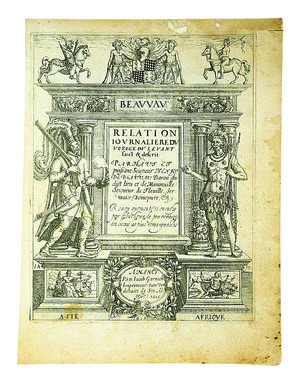 captured key aspects of Greek culture from the 15th to the mid-20th century. Publications with information passed down by scholars, poets, antiquarians, epigrammatists, travellers, diplomats, naturalists, pilgrims, archaeologists and historians, as well as rich visual material, compose a mosaic showcasing important aspects of the culture, economy and religions of the Greeks and other peoples from the Mediterranean and Southeastern Europe, as recorded by Western European travel writers.
captured key aspects of Greek culture from the 15th to the mid-20th century. Publications with information passed down by scholars, poets, antiquarians, epigrammatists, travellers, diplomats, naturalists, pilgrims, archaeologists and historians, as well as rich visual material, compose a mosaic showcasing important aspects of the culture, economy and religions of the Greeks and other peoples from the Mediterranean and Southeastern Europe, as recorded by Western European travel writers.
In addition to classic travel books by Clarke, Dodwell, Haygarth, Pococke, Pouqueville, Spon, Wheler, Dapper, Le Bruyn, et al., that are included in the Travel Collection of Onassis Library (which currently numbers 2,500 titles), other standout publications include The Adventures of Telemachus (Les aventures de Télémaque) by François Fénelon, Travels of Anacharsis the Younger in Greece (Voyage du jeune Anacharsis) by Jean-Jacques Barthélemy, The Survey of the World (De situ orbis libellus) by Dionysius Periegetes and Geographica of Strabo, as well as many others which were fully recorded (2003) across three catalogues and anthologised (2005) (see “Bibliography”). Furthermore, in accordance with the wishes and views of A. Papadimitriou, valuable archaeological studies published following the excavations carried out by foreign and Greek archaeological schools during the 19th century are also systematically collected. A prime example is the ten-volume edition on the excavations at Olympia: O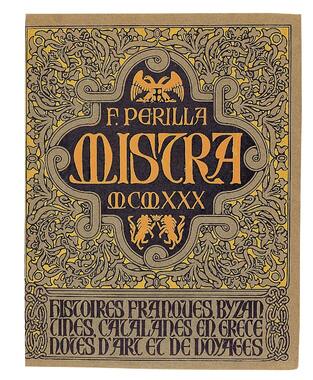 lympia. The Complete Collection of the First Archaeological Excavations Conducted by Curtius E. & Adler F. Between 1875–1881, containing 460 reproductions, full-page or spreads, colour drawings, sketches and maps. Normand’s publication (Charles Nicolas Normand, La Troie d’Homère: Explorations artistiques et archéologiques, L'ami des monuments et des arts, 1892) follows a similar trajectory.
lympia. The Complete Collection of the First Archaeological Excavations Conducted by Curtius E. & Adler F. Between 1875–1881, containing 460 reproductions, full-page or spreads, colour drawings, sketches and maps. Normand’s publication (Charles Nicolas Normand, La Troie d’Homère: Explorations artistiques et archéologiques, L'ami des monuments et des arts, 1892) follows a similar trajectory.
The year 2012 was without question a landmark year for the Foundation and the Onassis Library by extension, as, in addition to Kontominas library, which numbered 900 titles (1,500 volumes), the Foundation acquired some 1,000 further books of literature. Moreover, it was during that same year that the C. P. Cavafy archive came under the ownership of the Onassis Foundation.
20th Century Greek Literature. At the initiative of the Onassis Foundation’s president at the time, Antonis Papadimitriou, the Foundation’s Collection expanded to include publications of poetry and prose (whether printed or handwritten, illustrated or not) from the beginning of the 20th century onward. The collections of poetry, in particular, form a uniquely complete set, which includes works representative of all contemporary trends in letters during the 20th century, starting with the works of the neosymbolists of the 1920s (Kostas Ouranis, Kostas Karyotakis, Maria Polydouri, Tellos Agras, et al.). These poems are set apart by their pessimism combined with a sense of impasse and are clearly influenced by the dramatic events of the time (national discord, the Asia Minor catastrophe, military movements, brief dictatorships, etc.).
from the beginning of the 20th century onward. The collections of poetry, in particular, form a uniquely complete set, which includes works representative of all contemporary trends in letters during the 20th century, starting with the works of the neosymbolists of the 1920s (Kostas Ouranis, Kostas Karyotakis, Maria Polydouri, Tellos Agras, et al.). These poems are set apart by their pessimism combined with a sense of impasse and are clearly influenced by the dramatic events of the time (national discord, the Asia Minor catastrophe, military movements, brief dictatorships, etc.).
Unlike the neo-symbolist poets, their contemporaries Kostas Varnalis, Angelos Sikelianos and Nikos Kazantzakis were exponents of different aesthetic standards, and more idealistic and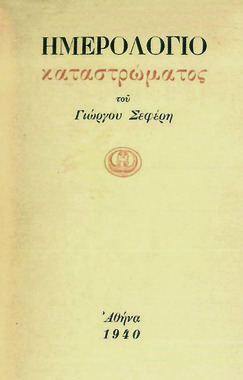 optimistic in tone. Also, from the mid-1920s, a number of poets (Kaisar Emmanouil, Orestis Laskos, Alexandros Baras, Yiannis Skarimbas, Nikos Kavvadias, Tasos Pappas) moved away from the established sentimentalism and the expressive devices of their slightly older contemporaries. Poetic works by all of them can be found in the poetry Collection of the Onassis Library.
optimistic in tone. Also, from the mid-1920s, a number of poets (Kaisar Emmanouil, Orestis Laskos, Alexandros Baras, Yiannis Skarimbas, Nikos Kavvadias, Tasos Pappas) moved away from the established sentimentalism and the expressive devices of their slightly older contemporaries. Poetic works by all of them can be found in the poetry Collection of the Onassis Library.
The Library also includes works by all the important Greek poets of the “generation of the ’30s”.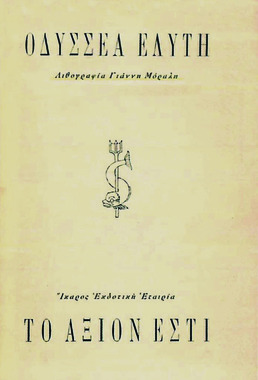 Influenced by modernism and other related movements, such as expressionism and surrealism, those creators came to disrupt traditional aesthetics with their use of free verse and their exploration of the strong connections between past and present. Exponents of those avant-garde movements, whose works are also found on the shelves of Onassis Library, include Giorgos Seferis, Odysseas Elytis, Andreas Embirikos, Nikos Engonopoulos, Yiannis Ritsos, Nikiforos Vrettakos, et al.
Influenced by modernism and other related movements, such as expressionism and surrealism, those creators came to disrupt traditional aesthetics with their use of free verse and their exploration of the strong connections between past and present. Exponents of those avant-garde movements, whose works are also found on the shelves of Onassis Library, include Giorgos Seferis, Odysseas Elytis, Andreas Embirikos, Nikos Engonopoulos, Yiannis Ritsos, Nikiforos Vrettakos, et al.
It should be noted that a distinctive feature of the publications of the “Generation of the ’30s" were the illustrations by prominent visual artists of the time, such as Yiannis Moralis, Nikos Hadjikyriakos-Ghikas, Yannis Tsarouchis,  Nikos Engonopoulos, et al. The Onassis Library features many exceptional examples, such as the Museum of Athens’ monumental publication of Ten White Lekythoi by Jean Kefalinos, Axion Esti by Odysseas Elytis illustrated by Yiannis Moralis, the Poems of C. P. Cavafy illustrated by Takis Kalmouchos, as well as publications of Nikos Engonopoulos, such as his collection Bolívar, illustrated with the poet’s own artwork.
Nikos Engonopoulos, et al. The Onassis Library features many exceptional examples, such as the Museum of Athens’ monumental publication of Ten White Lekythoi by Jean Kefalinos, Axion Esti by Odysseas Elytis illustrated by Yiannis Moralis, the Poems of C. P. Cavafy illustrated by Takis Kalmouchos, as well as publications of Nikos Engonopoulos, such as his collection Bolívar, illustrated with the poet’s own artwork.
Organisation and digitisation. The books of the Onassis Library are classified into six subject categories: Liturgical, Renaissance / Humanism, Theology, Modern Greek literature, Neohellenic Enlightenment, Travel. The incunabula and post-incunabula of the Staikos Collection, the Travel Collection and the Literary Collection have had transparent bookmarks placed in them with alphanumeric taxonomic codes indicating the section to which they belong and the book’s location in the library shelves. The new acquisitions of the Library are gradually documented, classified and temporarily stored in a separate area, until they are digitised and made freely available online.
The Library has released a printed catalogue for its Hellenic Library (see “Bibliography”) as well as a digital catalogue for all collections. In 2013, the digitisation project of the Onassis Library commenced with the co-financing of the Greek State and the European Regional Development Fund. 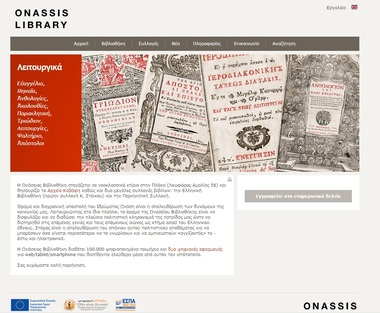 The project’s first phase was completed in 2016, covering the Hellenic Library in its entirety, in addition to part of the Travel Collection. In total, more than 110,000 documents were digitised and made accessible to all through the Onassis Foundation Digital Library as well as the Greek National Aggregator for Digital Cultural Content website. This website is a unified cultural information space developed by the National Documentation Centre (EKT) in collaboration with the “Digital Convergence” Operational Programme with the objective of assembling all Greek Digital Cultural Content produced by publicly funded institutions.
The project’s first phase was completed in 2016, covering the Hellenic Library in its entirety, in addition to part of the Travel Collection. In total, more than 110,000 documents were digitised and made accessible to all through the Onassis Foundation Digital Library as well as the Greek National Aggregator for Digital Cultural Content website. This website is a unified cultural information space developed by the National Documentation Centre (EKT) in collaboration with the “Digital Convergence” Operational Programme with the objective of assembling all Greek Digital Cultural Content produced by publicly funded institutions.
In addition, in order to showcase its digitised material even more, the Onassis Library has developed two digital applications for the web and Android tablets/smartphones, which are freely available on the Onassis Foundation page on Google Play. Using the application “Turning the Pages of Homer's Odyssey”, adults and children alike can browse one of the first editions of the Homeric epic printed in 1542 in Venice by the house of Giovanni Farri & Fratres. In the second application, called “Timeline of Hellenic Typography”, users have the opportunity to follow the history of publications, publishing houses and important printers from the 15th to the 19th century through a map.
Since 2016, the Onassis Library building has been open to visitors, offering cultural activities and educational programmes, guided tours and exhibitions to the general public.
C. P. Cavafy Archive. Consisting of more than 1,798 documents, the 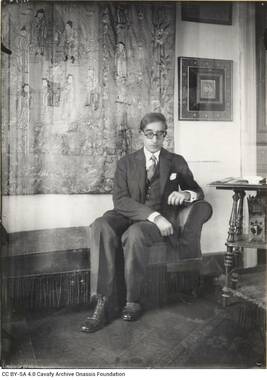 archive of the great Alexandrian poet includes manuscripts of his poems, makeshift printed editions, literary texts in prose, articles and studies on his work and notes by the poet himself. The Cavafy archive to Onassis Foundation in 2012, along with the archive of Cavafy’s heir and of the first curator of the poet’s archive (from 1926 to 1939), Alekos and Rika Segopoulos.
archive of the great Alexandrian poet includes manuscripts of his poems, makeshift printed editions, literary texts in prose, articles and studies on his work and notes by the poet himself. The Cavafy archive to Onassis Foundation in 2012, along with the archive of Cavafy’s heir and of the first curator of the poet’s archive (from 1926 to 1939), Alekos and Rika Segopoulos.
The Onassis Foundation did not limit itself to only rescuing the Cavafy archive, preventing its possible fragmentation and ensuring that it remained in Greece. It also proceeded with its digitisation and detailed documentation with the ultimate goal 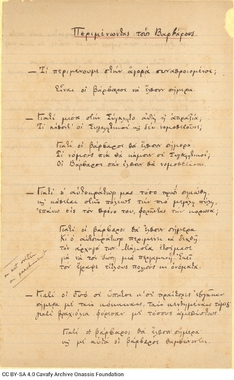 of making it freely available to the public. A total of 11,086 photographs were taken, capturing the archival material in its entirety, while all 158 microfilms (4,741 photographs) pertaining to the original photographing of the archive which began in 1963 by the professor and scholar of modern Greek literature Giorgos P. Savvidis (1929–1995) were digitised as well. The Digital Collection of the Cavafy Archive, available in Greek and English, is readily accessible to everyone on the website created by the Foundation. Furthermore, using the material of the archive as cornerstone, the Onassis Foundation regularly hosts educational activities, research seminars, educational programmes for adults and workshops for teachers and students, with the aim of disseminating Cavafy’s work and strengthening archival education.
of making it freely available to the public. A total of 11,086 photographs were taken, capturing the archival material in its entirety, while all 158 microfilms (4,741 photographs) pertaining to the original photographing of the archive which began in 1963 by the professor and scholar of modern Greek literature Giorgos P. Savvidis (1929–1995) were digitised as well. The Digital Collection of the Cavafy Archive, available in Greek and English, is readily accessible to everyone on the website created by the Foundation. Furthermore, using the material of the archive as cornerstone, the Onassis Foundation regularly hosts educational activities, research seminars, educational programmes for adults and workshops for teachers and students, with the aim of disseminating Cavafy’s work and strengthening archival education.
The Cavafy archive, together with the Cavafy Library, as well as the collection of personal effects and works of art making referenceg to the poet, will soon be permanently relocated to a specially designed space in Plaka.
Historical Archive (19th–20th century). Over the last decade and at the initiative of its president, Onassis Foundation 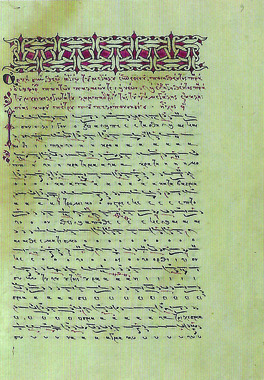 has created a Historical Archive consisting of documents (manuscripts, typescripts and printed materials) in Greek and other languages, either stand-alone or parts of collections, in addition to complete private collections (e.g. the entire archive of N. M. Verveniotis from Hydra, and part of the Gryparis archive). This material covers the last two centuries of Greek history, from the early 19th century to the last decades of the 20th century.
has created a Historical Archive consisting of documents (manuscripts, typescripts and printed materials) in Greek and other languages, either stand-alone or parts of collections, in addition to complete private collections (e.g. the entire archive of N. M. Verveniotis from Hydra, and part of the Gryparis archive). This material covers the last two centuries of Greek history, from the early 19th century to the last decades of the 20th century.
The manuscripts and typescripts of the Historical Archive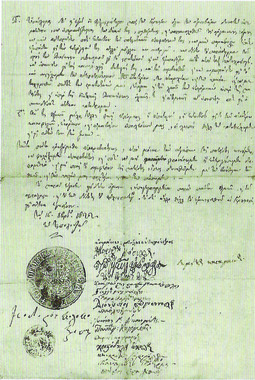 are mainly original texts by important individuals from the political, military and intellectual world, diaries, literary and critical texts, poetry, military reports and accounts, etc. For example, the following are all preserved:
are mainly original texts by important individuals from the political, military and intellectual world, diaries, literary and critical texts, poetry, military reports and accounts, etc. For example, the following are all preserved:
- Signed letters by Georgios Karaiskakis and Theodoros Kolokotronis from the 1826–1827 season.
- Parchment signed by Queen Victoria of England (1819–1901), Balmoral Castle, 8 October 1897.
- Handwritten journal of the 10th Company from the 1/38 Evzones Regiment in Asia Minor, recording the operations of June 1920.
- Typescript of Galatea Kazantzakis’ unpublished and unperformed play “Peasants, A Drama in Three Parts” [1933].
- Signed typed letter from the soprano Maria Callas to the director general of the Greek National Opera, Costis Bastias, in English (Milan, 1963).
The section of printed works consists of single sheets, double sheets, brochures, newspaper sheets, etc. of varying content featuring advertisements, pamphlet, political and military texts, war journals, literary texts, et al. These include the following files of great relevance to Greek history:
- The first edition of the “Provisional Regime” of Greece, 1 January1822.
- Anexartitos Efimeris tis Ellados (Independent Newspaper of Greece), issue 1, Hydra, 30 July, 1827.
- Circular of the “Commission on Finance”, declaring the auction of the national revenues of the Greek state, Nafplio, 4 January 1832.
- Amalia Papastavrou, Discovered war diary, Alexandria 1897.
- Pages from the newspapers Antifasistas (The Antifascist) and Eleftheria (Freedom), organs of Greek resistance organisations in Cairo, 1942–1943.
Aristotle Onassis Archive. The Onassis Archive (comprised of over 1,000,000 artefacts) came about as the result of a research project commissioned by the Onassis Foundation to the Center of Maritime History of the Institute for Mediterranean Studies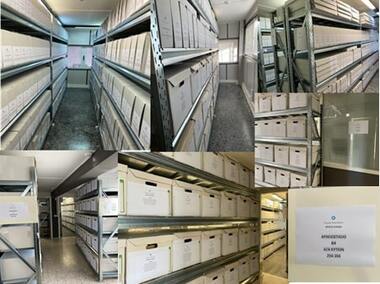 of the Foundation for Research and Technology — Hellas and carried out by a team of historians and archivists, from July 2017 until January 2021. The project had two objectives: a) the creation of Onassis Archive and b) the composition of a study on the history of Onassis businesses. As Amalia Pappa, Deputy Director of the General State Archives states regarding the significance and importance of Onassis Archive:
of the Foundation for Research and Technology — Hellas and carried out by a team of historians and archivists, from July 2017 until January 2021. The project had two objectives: a) the creation of Onassis Archive and b) the composition of a study on the history of Onassis businesses. As Amalia Pappa, Deputy Director of the General State Archives states regarding the significance and importance of Onassis Archive:
“The high degree of [the Archive’s] completeness gives it added value, as it captures the history, hierarchy and timeline of successions within the group, while highlighting all the business activities and their evolution, the functions and overall management of the group”. More specifically:
- It covers the entire period of Aristotle Onassis’ entrepreneurial activity from 1924 to 1975, and the Foundation’s activity from 1975 to 2009.
- The business archive covers a large time span within the 20th century (1939–2009) and, together with the acquired collections of Mantidis and Maros, dates back to at least 1924.
- It is the only currently known record of a shipping company in Greece that has been preserved to such an extent.
- It is the only currently known record of a shipping company in Greece that has been utilised to such an extent.
- It preserves a wide range of document types (written documents, photographs, film).
- It preserves part of the Onassis family archive.
- It is complemented with material from other smaller archives, which were subsequently added and contribute valuable information to the Onassis family archive in its entirety.
The significance of the Aristotle Onassis Archive (1924–1975)
The Onassis Business Archive marks a new era in the history of shipping, both in Greece and on a global level. Onassis Foundation is following in the footsteps of its creator with a pioneering project. The Onassis Business Archive is the first Business Archive of a Greek-owned private business group in shipping — and many other avenues — worldwide. With a time span ranging from 1924 to 1975 and a geographical scope covering Europe, the Americas and Asia, it details the management of 140 ships, and provides the entrepreneurial and administrative documents for 225 Panamanian and Liberian companies in addition to personal documents and visual material on Aristotle Onassis and his family.
The project in numbers:
A. Physical Archive. The physical archive (subcategorised into a “Pre-1975 Archive” and a “Post-1975 Archive”) presently consists of:
- 4,992 files (Onassis Business Archive).
- 464 artefacts (Onassis Family Archive: The family archive, for the most part, has been documented and archived by artefact, i.e. by document or photograph and not by file, due to the rarity and value of the material).
It is sorted into 1,350 boxes.
- Pre-1975 Archive: 675 acid-proof archival boxes containing approximately 350,000 documents.
- Post-1975 Archive: 111 acid-proof archival boxes.
- Other material: sorted into 475 storage boxes.
- Collections: 4 boxes containing belongings of the Onassis family.
Archive of framed pictures relating to the Onassis Group post-1975.
B. Book. The book consists of 15 chapters, 710 pages and 207,966 words, while its English translation is also underway.
C. Research Tool. The research tool used for the classification of the Archive’s documents, as well as the function of searching through them, is available on the Archive Max online platform and includes 5,333 entries. So far, 122 digitised volumes have been posted featuring the statutes of the companies, the minutes from the meetings of the boards of directors and general shareholder meetings, as well as other documents related to the first 80 companies of the Onassis Group up to 1975.
Library Catalogues
Greek Library: The Konstantinos Sp. Staikos Book Collection henceforth the Alexander S. Onassis Public Benefit Foundation Library, edited by G. Xourias, Athens, Aton, 2011.
Greek civilisation through the eyes of travellers and scholars: the Library of Dimitris Contominas, edited by Leonora Navari, Athens, Kotinos, 2003.
Bibliography on the Library
The Hellenic World Through the Eyes of Travellers (15th–20th century): Selections from the Dimitrios Kontominas Collection, Exhibition Catalogue (February 8–March 6, 2005, Benaki Museum), introduction and commentary by Ioli Vigopoulou, Athens, Kotinos, 2005.
The Emergence of Centres of Hellenism in the Voyages of Travellers (15th–20th century): Selections from the Dimitrios Kontominas Collection, Exhibition Catalogue (May 16–June 16, 2005, National and Kapodistrian University of Athens, Kostis Palamas Cultural Centre) , introduction and commentary by Ioli Vigopoulou, Athens, Kotinos, 2005.
500 Years of Greek Typography (1499– 1999), edited by T. E. Sklavenitis and K. Sp. Staikos, Athens, Hellenic Parliament, 2000.
Ricordo della visita di S.E. il Presidente della Repubblica Italiana on. Sergio Mattarella alla Biblioteca della Fondazione di Pubblica Utilità Alexander S. Onassis, Athens, January 18, 2017, introduction by K. Sp. Staikos, translated by Alexandra Vouvousiras, Athens, Aton, 2017.